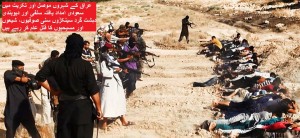Different Salafi movements and the growth of ISIL in Iraq
Turkish intellectuals are largely ignorant about the new threat that is bordering Turkey.
The so-called Islamic State of Iraq and the Levant (ISIL) is still an unknown entity for Turks. We have been hearing comments declaring that all the Salafi movements are terrorists, or equating Salafism with al-Qaeda. People who cannot differentiate between purist Salafis and jihadist Salafis; who cannot see the potential of purists to be converted into jihadists; and who could not realize the danger until the takeover of Mosul are now trying to address issues like the strategies, logistics and tribal relations of ISIL.
To be frank, I also failed to realize the emergence of Salafi groups as significant players in Arab politics until the electoral success of the al-Nour Party in Egypt. I regarded the Salafis of Najd, Qatar and the United Arab Emirates (UAE) as mainly purist movements within Sunni Islam. All they asked for was the purification of the Muslim mind from innovations added to the main body of Islam throughout the centuries that followed the era of the Prophet. A particular innovation that they wanted Muslims to keep themselves purified from was politics.
But the thin line between purifying oneself from innovations and purifying society and politics from innovations can easily be crossed in a context where people suffer from tyranny and persecution. And if a politicized faith system like Shia is regarded as the gravest innovation that needs to be cleansed, the politicization of purist Salafism is inevitable. That is exactly what happened. A bunch of Kuwaiti Salafi scribes converted purist Salafism into a political Islamist Salafi activism. Once politicized, it was inevitable that Salafism would also resort to violence. After all, according to jihadist discourse, some innovations can be torn down only with the sword.
Jihadist Salafism found fertile ground among the Sunnis of Iraq, Syria and Lebanon, where enmity toward Shiites was already well established. The American occupation of Iraq, the Baath dictatorship in Syria and pressure from Hezbollah and al-Amal in Lebanon attracted jihadists from all around the world to the region. The Syrian unrest introduced two jihadist groups to the Middle Eastern scene: the al-Nusra Front and the Islamic State of Iraq and the Levant (ISIL). For a long time al-Nusra was the larger group and a merger between the two didn’t work. Now that ISIL has managed to invade Mosul with a small number of militants, it deserves more attention. The world first heard the name of ISIL within the Syrian context, but the organization was founded in Iraq. The founding cadres of the organization were all Iraqi Sunni Arabs. But soon after it joined the Syrian opposition, it started to attract fighters from Europe, the US, the Caucasus and Turkey. Chechen commanders undertook the military restructuring of the organization and Sunni members of the old Saddam Hussein regime helped it to metamorphose into an embryonic state, with a cabinet and ministers dealing with a range of issues from oil to fisheries.
During this metamorphosis, ISIL replaced its early jihadist Salafi ideology with the pragmatic ideal of the unification of the Muslim Ummah under a caliphate, plus a strong enmity for the Shiites. This gave way to a struggle for the souls of the fighters between ISIL and al-Nusra, and ISIL managed to attract most of al-Nusra’s experienced fighters. More importantly, ISIL started to create its own myths. Nowadays Iraqi and Syrian Sunnis are telling the saga of a handful of ISIL fighters who took over the city of Mosul, protected by some 30,000 soldiers and with a population of nearly 2 million. With time, this myth will take on elements of divine intervention and it will be almost impossible for Sunni fighters not to be attracted to the organization. In fact, it is almost certain that the regional tribes, pro-Saddam elements and fighters from abroad who long for the unification of the Ummah and the reestablishment of the Caliphate are already joining the ranks of ISIL.
Such an organization cannot be destroyed from without. Given the fact that the military strategy of ISIL is largely shaped by the Chechen-Dagestani fighters, further metamorphosis seems more plausible than destruction. The jihadi Salafis can be convinced to turn back to their more responsible purist Salafi positions and later integrated into the Naqshibandi orders that are strong both among the peoples of the Caucasus and the Kurds of Iraq. With its strong Naqshibandi orders, Turkey may play a positive role in this transformation.
Source :
http://en.cihan.com.tr/news/Different-Salafi-movements-and-the-growth-of-ISIL_7650-CHMTQ2NzY1MC81


Nice blog here! Also your site lots up very fast! What host are you the usage of? Can I am getting your associate link in your host? I wish my website loaded up as fast as yours lol
portafogli economici Louis Vuitton http://www.hotelvillalauri.com/images/servizi/nklf.asp
Different Salafi movements and the growth of ISIL in Iraq
aqerngbtfko
qerngbtfko http://www.g8d4891tu137t3tc41ahh655eo6ve7fbs.org/
[url=http://www.g8d4891tu137t3tc41ahh655eo6ve7fbs.org/]uqerngbtfko[/url]